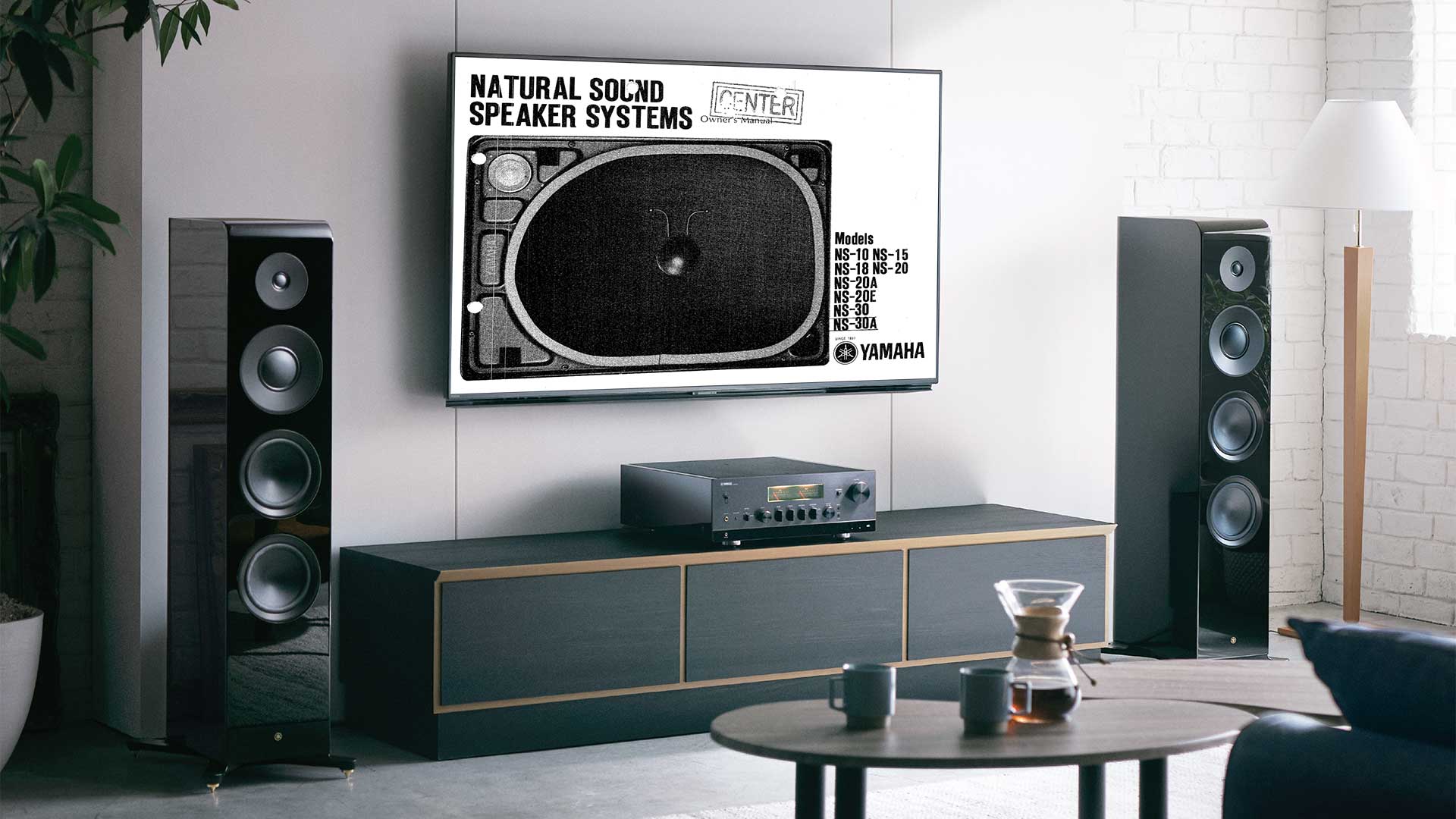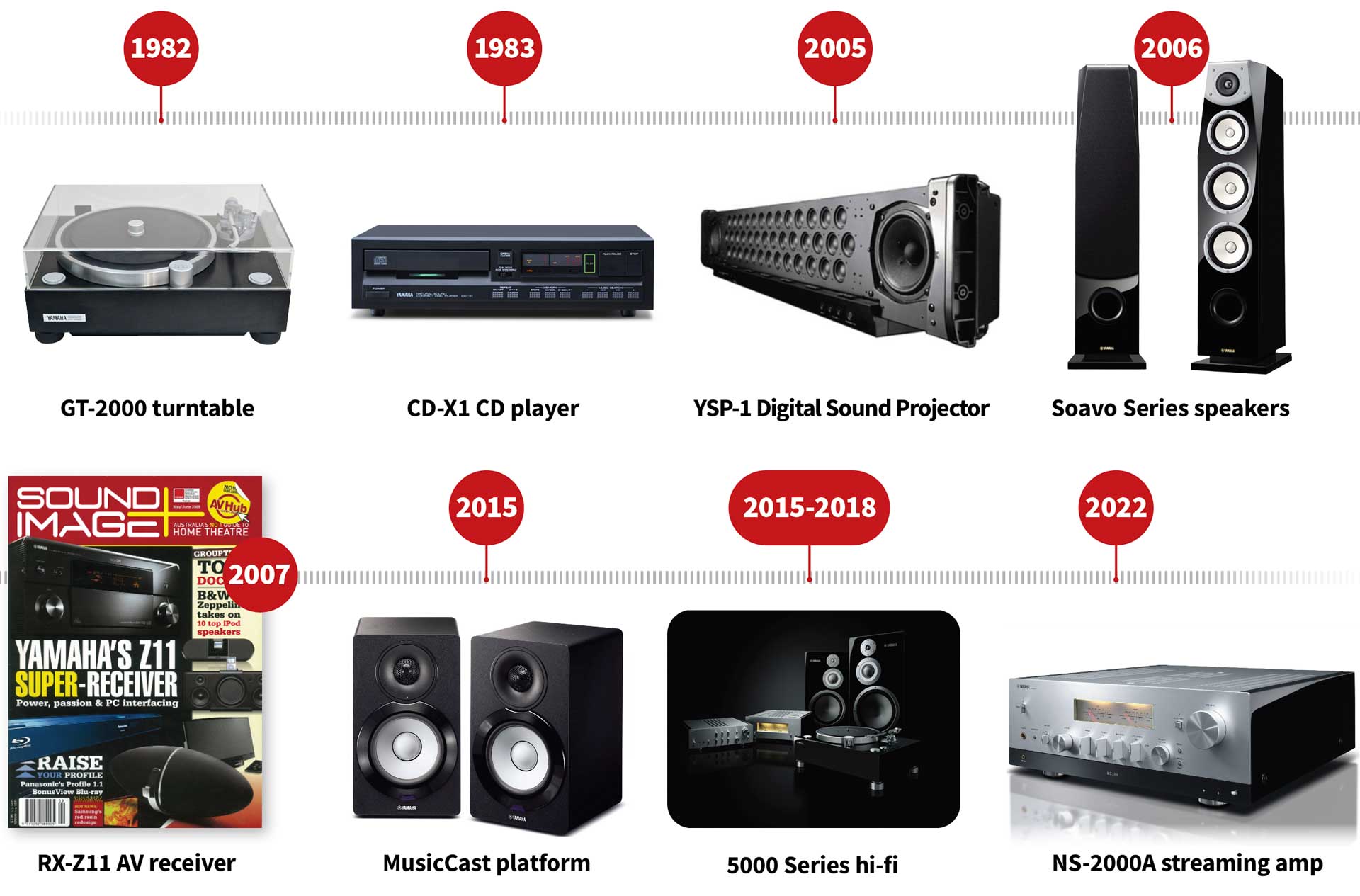A short history of Yamaha hi-fi
From pianos and organs to wind-up gramophones and then the first 'Hi-Fi Player' in 1954, we trace the Japanese company's path through to today's production of wireless speakers, soundbars and high-end hi-fi
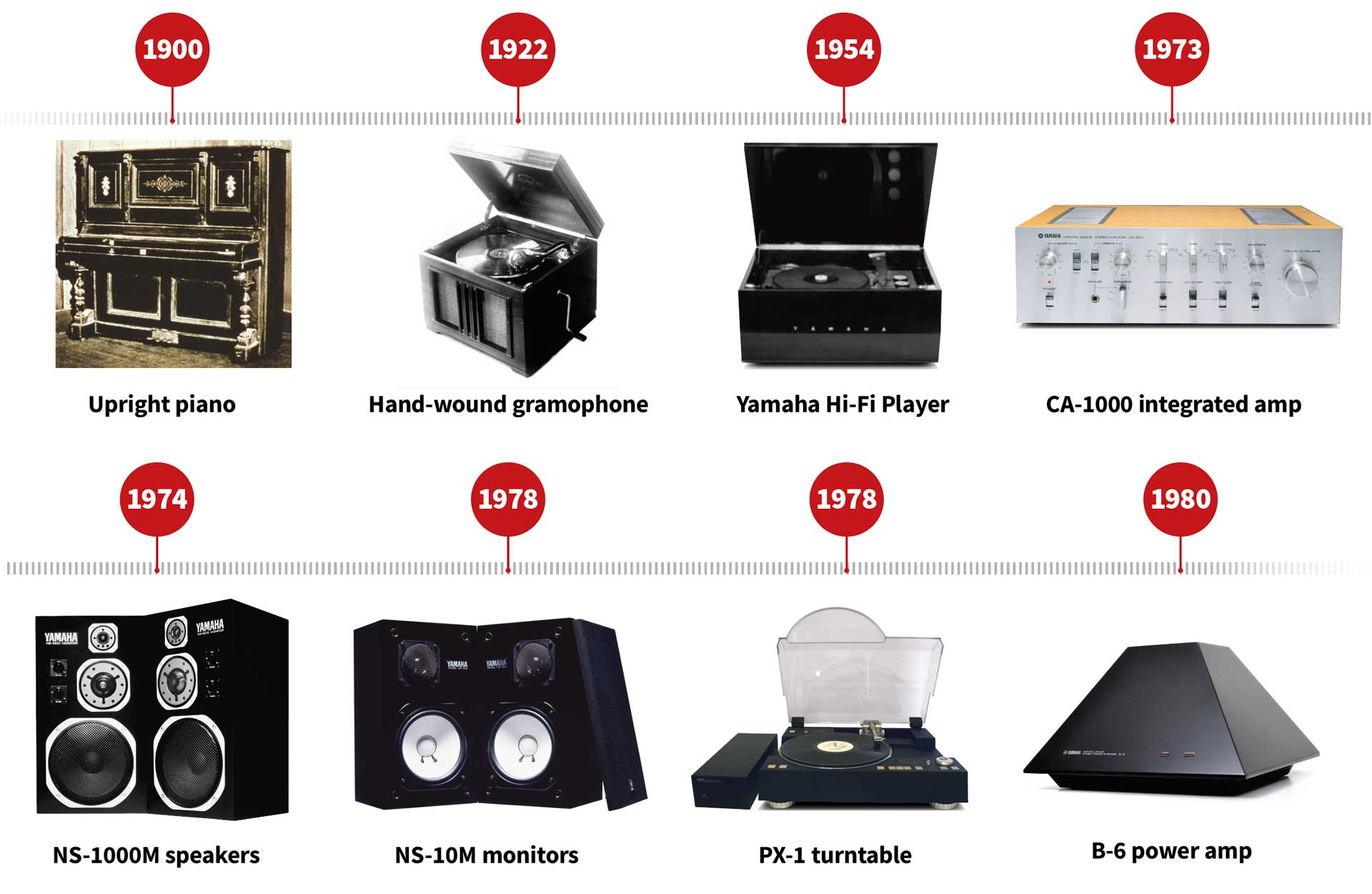
Yamaha makes one key claim to its position within the original Golden Age of post-war audio, when the very concept of “high fidelity” was first being established through a string of technological and material advances in the late 1940s and into the 1950s. In 1954 it released the ‘Yamaha Hi-Fi Player’ pictured below, a record player claimed to be the world’s first audio component bearing the word ‘Hi-Fi’ in its name. It’s a product remembered by the company as delivering “sure sound and durability”.
But by 1954 Yamaha had already been in existence more than half a century. The founder was Torakusu Yamaha, who built the first reed organ in Japan after learning how to repair a broken one, and founded the company as a manufacturer of reed organs and pianos at the end of the 19th century.
The company’s logo reflects these origins, with its crossed tuning forks – the original had a Chinese phoenix with the fork in its mouth; the current version dates from 1916.
A hand-wound gramophone was among Yamaha’s releases in 1922, while the mid-1950s brought those ‘Hi-Fi’ products. So were they really the very first to be called ‘Hi-Fi’?
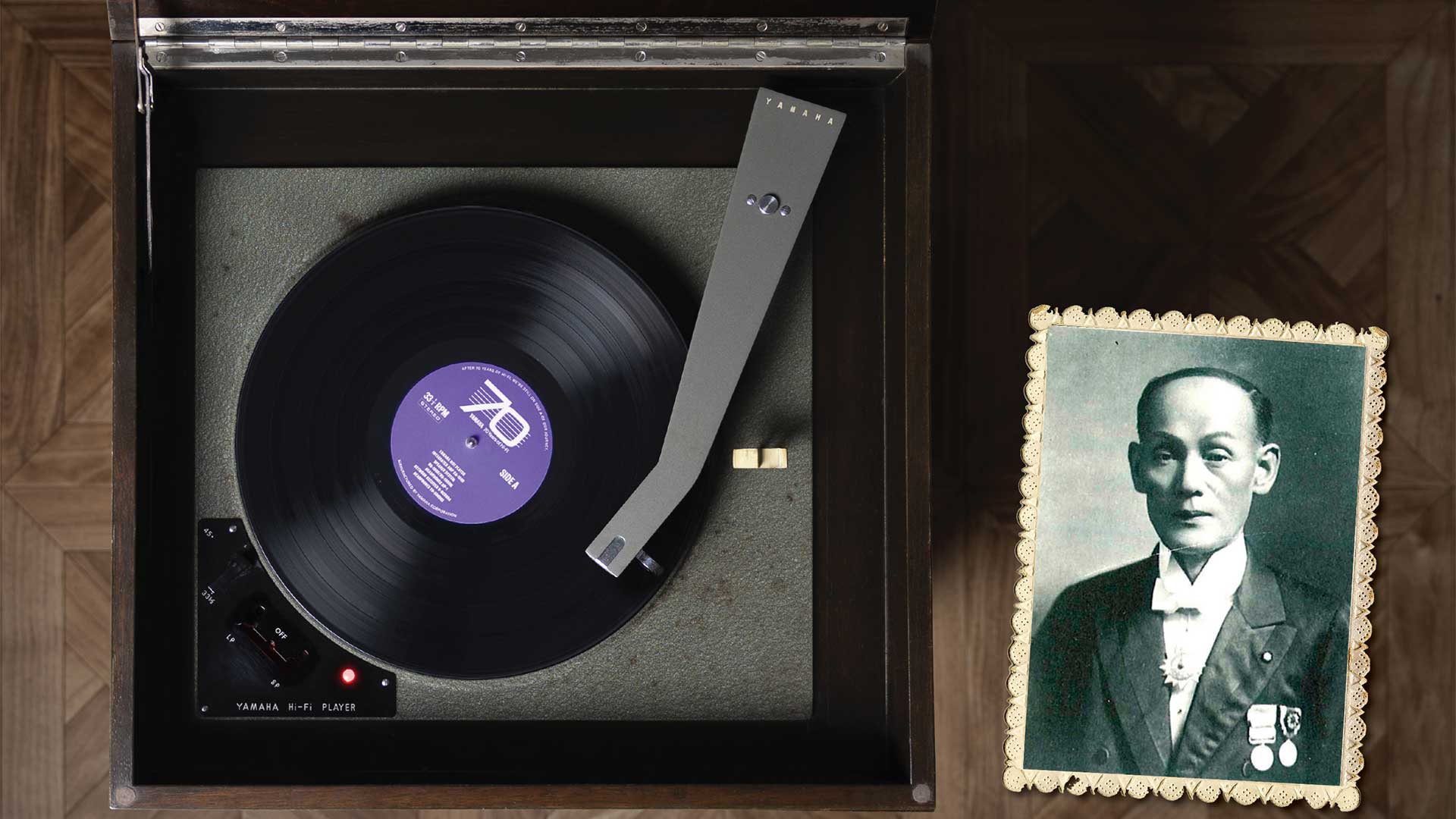
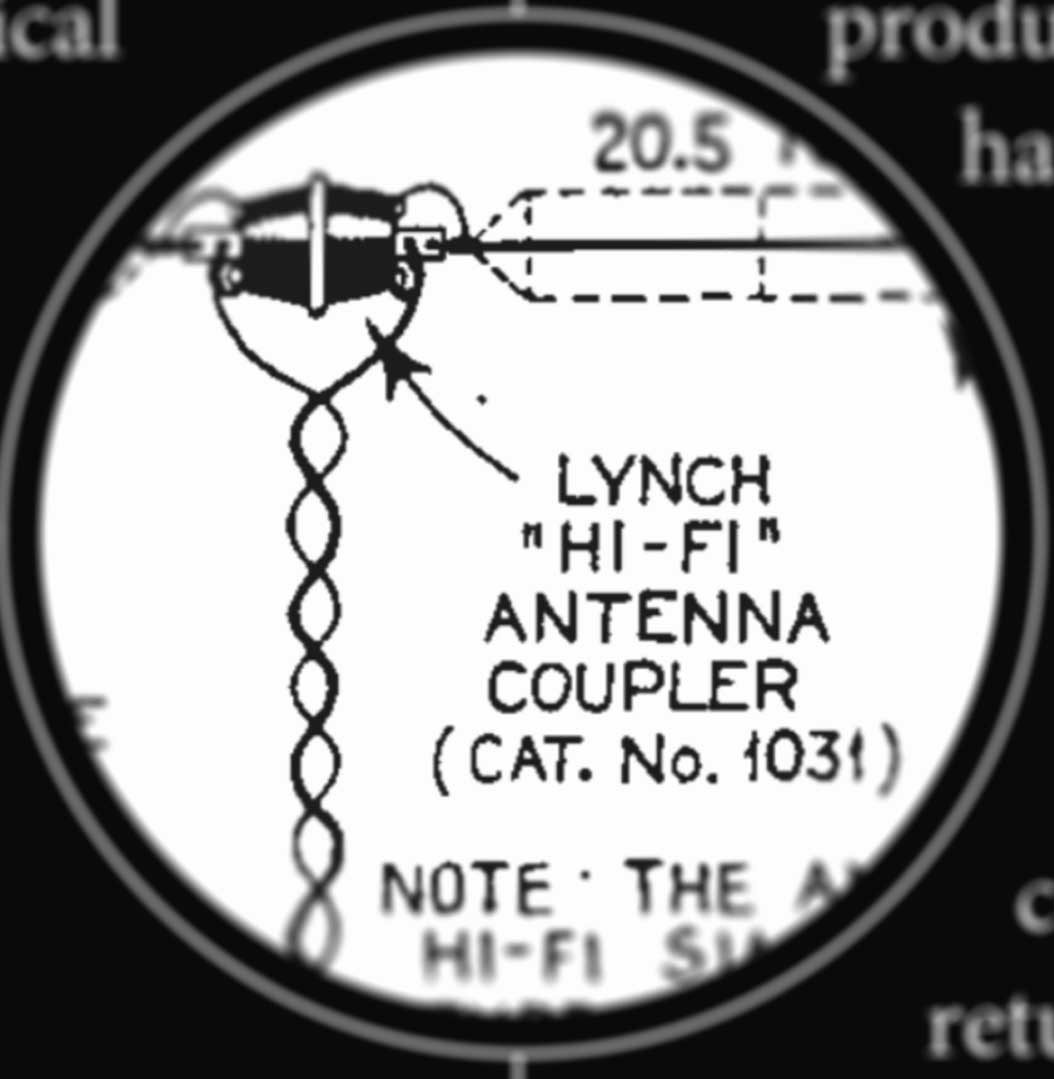
Well, the Oxford English Dictionary dates the term ‘hi-fi’ all the way back to 1935, quoting an issue of Short Wave Craft mentioning Lynch hi-fi kits (as shown right in an excerpt from a circuit appearing in National Radio News, June-July 1935).
But as applied to a finished product, Yamaha does indeed seem to have been first to sell a hi-fi product as ‘Hi-Fi’!
Moving into the 1960s, mind you, Yamaha was sidelining its hi-fi development in favour of electronic organ production, and also motorcycles, which became a separate company. But those organs did bring with them a new development, and it would be one that has lasted all the way through to Yamaha's ranges today: 'Natural Sound' speakers.
The latest hi-fi, home cinema and tech news, reviews, buying advice and deals, direct to your inbox.
Natural Sound
It’s quite a pedigree – Yamaha’s latest loudspeakers carry the same ‘NS’ prefix as the company’s first ‘Natural Sound’ speaker back in 1958, the NS-20 (pictured above on the TV between Yamaha's current 'NS-2000A' speakers).
The NS-20 used the principles of a piano soundboard in a speaker for the home. The ‘Natural Sound’ slogan has since been affixed to everything from CD players to receivers to in-wall speakers – indeed it began with the speaker for Yamaha’s Electone organ series (the 1959 B-1 is pictured below). There’s no single philosophy behind it, except perhaps a regard for simplicity in achieving purity of sound.
“It means just what it says – Natural Sound”, as one Yamaha Music Australia staff member once sagely told us.

Only in 1967 did Yamaha return to home audio, taking the ‘Natural Sound’ speaker from its Electone organ series and repurposing it as a hi-fi speaker. The JA6002 and 5002 woofer units were used in the first NS-30 and NS-20 speakers, designed to incorporate grand piano soundboard principles for greater sound dispersion from these huge woofers.
Then came audio systems more or less as we know them today, starting with the first generation of component stereo in 1972, the 700 Series, with the YP-700 record deck, the CT-700 tuner, TB-700 cassette deck and the star of the series, the CA-700 amplifier. A less expensive pairing of YP-500 record player and CA-500 amplifier was also available.
The 700 Series amplifier was fully equipped with separate MM and MC phono inputs, and a stereo microphone input on the front panel with volume adjustment, so that these products found their way beyond the home into education, shop environments and other semi-pro uses. They also introduced what would become a Yamaha staple, the NF tone control, known as the “Yamaha method”.
In 1973 came the 1000 Series, among which the CA-1000 amplifier was a classic, cementing the sleek industrial design link with GK Design, with a single-sheet aluminium front fascia (version 1 without the VU meters which were soon added) that might easily slip among a current set of Yamaha separates.
As well as amping up the style, the CA-1000 could switch its modes of amplification – a world-first way to go from low-distortion, sound-priority Class A to high-power party-mode Class B, resourced by two 18,000μF block aluminium electrolytic capacitors, huge by the standards of the day.
Three years later the CA-2000 made signal to noise improvement its theme, with Yamaha developing in-house silicon to achieve it.
It’s no coincidence that ‘1000’ and ‘2000’ Series continue in Yamaha’s hi-fi range today. These 1970s’ products defined both the company’s look, and its sound philosophy.
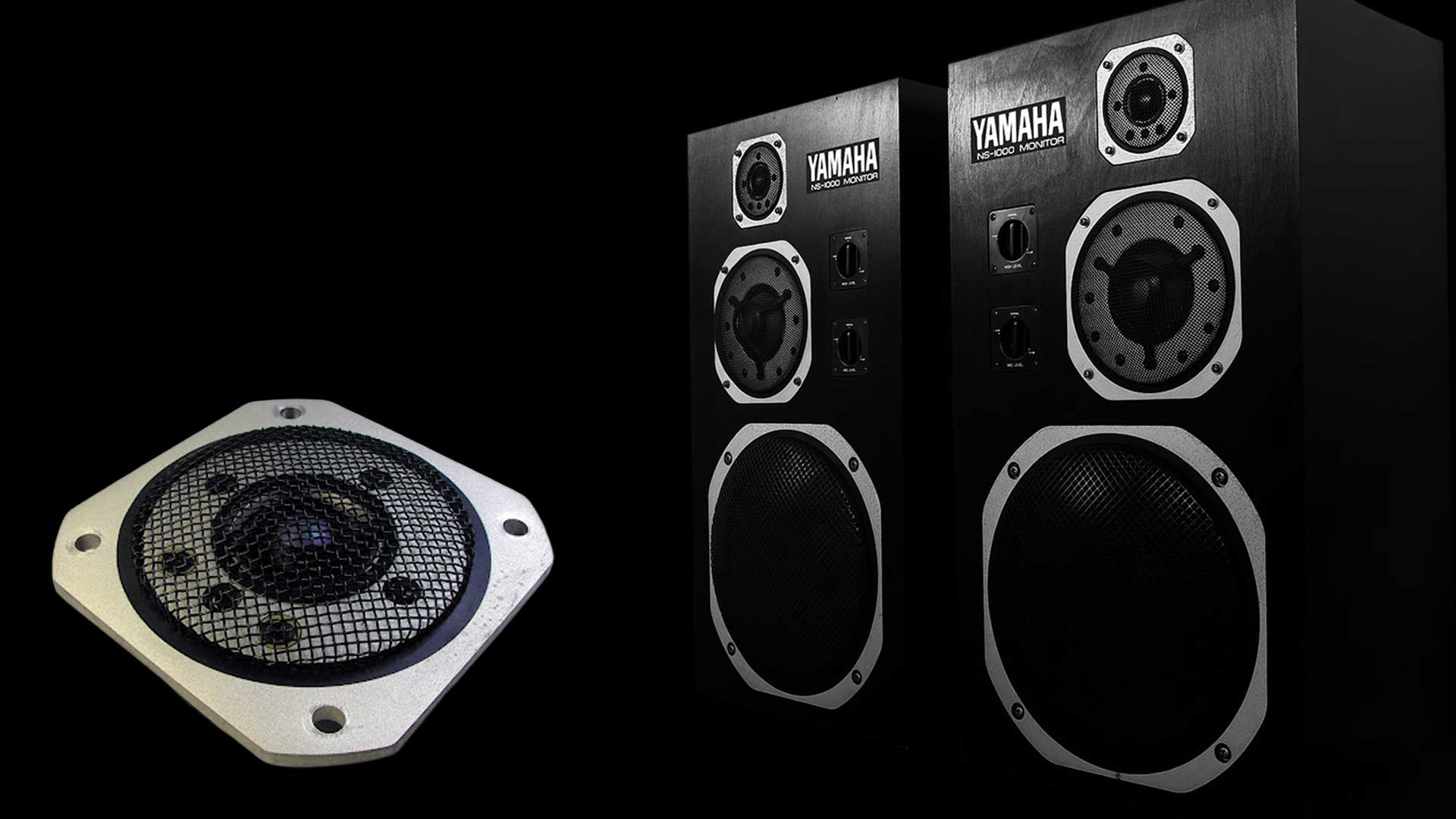
A classic – the NS-1000 loudspeakers
In 1974 came the NS-1000 loudspeaker – of which we heard much in recent years when it inspired the modern NS-5000 speakers launched in 2015 as the start of a new 5000 Hi-Fi series.
The great innovation back in 1974 was the introduction of beryllium vacuum deposition. Beryllium’s properties were well enough known – it had the classic combination of stiffness and lightness desirable in a loudspeaker cone, its ‘numbers’ superior to other options such as titanium, aluminium or magnesium. But its resistance to stretching or bending caused it to split under any attempt to form it into a shape for use in a loudspeaker driver.
Yamaha managed to overcome the problems by electro-beam vacuum deposition and a special alloy technology developed in its piano frame building. With an aluminium substrate and a pre-shaped copper former, Yamaha achieved a diaphragm of 99.99% pure beryllium plasma, used not only for the JA-0513 33mm tweeter but also the JA-0801 88mm midrange driver. The JA-3058 bass driver was a 12-incher using a more conventional paper cone, nevertheless developed especially for the NS-1000.
The new design was not an immediate ‘classic’. In the hi-fi market it wasn’t helped by being sized too small to be a traditional floorstander yet too large and heavy for bookshelf use. And the speakers pushed 39kg each, with the solid polyurethane-coated ebony finish not mere veneer but proper solid wood.
But it did solicit some high praise from audio magazines which had, in the main, not thereto been great believers in Japanese loudspeakers. Despite reservations about ‘metallic’ drivers sounding, well, metallic, the NS-1000 soon increased in popularity through its performance. The pro ‘M’ model became the official monitoring speaker of Sweden and later Finland, and the speakers remained in production, with variations, for 23 years, until beryllium diaphragm production was ended in 1997.
From home to the studio
Launched in 1978, the Yamaha NS-10M was a surprise market-jumper, designed as a hi-fi speaker but finding greater success as an effective but inexpensive nearfield monitor for pro sound freelancer producers.
Like the NS-1000 it was designed by Akira Nakamura but was relatively unremarkable in specifications and technologies, and it didn’t receive particular acclaim for its domestic market. Bob Clearmountain is credited as one early producer who began using the NS-10 when he needed easily-portable speakers to carry from studio to studio as a fixed reference for mixing (he is also credited for the use of tissue paper over their tweeters to dull their bright sound). As the word spread in the early 1980s, studios began buying NS10s in their hundreds, then thousands, though it took nearly a decade for a version badged ‘NS10M Studio’ to appear, reinforced to handle more power – and with reduced high frequency response (no tissue paper required).
Meanwhile Yamaha’s PX-1 turntable impressed domestic hi-fi fans when released the same year (1978). This used a symmetrical linear arm and electronic control to reduce tracking errors and unbalanced stress on the sound groove, while aiming to eliminate vibration and noise associated with the movement of the arm.
Four years later, just as CD was making its debut, Yamaha delivered the GT-2000, a large heavyweight vinyl player 55cm wide (the GT stood for ‘Gigantic and Tremendous’), achieving playback from overengineered bearings and motor, and a more conventional S-shaped long arm.
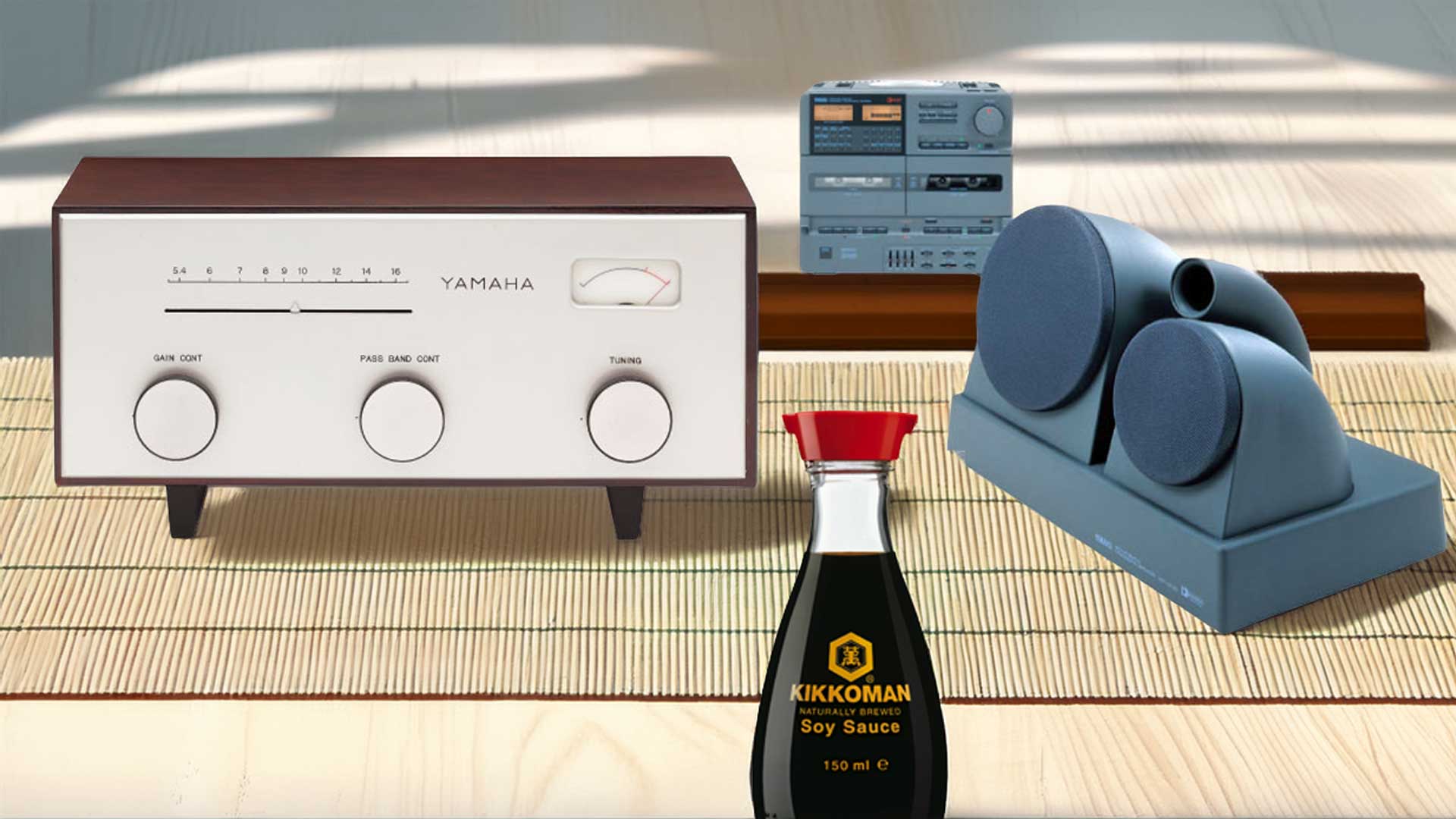
The GK connection
While Yamaha dates its ‘Hi-Fi’ birth to the Yamaha Hi-Fi Player, there is another product of the same period which looks far more ‘Yamaha’ than that Hi-Fi Player – the Hi-Fi Tuner R-3, pictured above left.
Both products enjoyed design input from GK Design, then a young group of industrial designers calling themselves Group Of Koike (GK), born only a year earlier from a community of Tokyo National University of Fine Arts students who advocated industrial design ahead of more traditional crafts, and aiming for “democratisation of beauty” and for “democratisation of things”. Among the GK group was Kenji Ekuan, who went on to lead GK and design the iconic Kikkoman soy sauce bottle, more for Yamaha – and the classic Akita Shinkansen Komachi bullet train, before his death in 2015.
“I tried authentic design approaches at the time when commercial American design was enjoying deliberate refinement,” remembered Kenji Ekuan of those early designs. “Thinking back, I find the Yamaha Hi-Fi tuner that GK designed in 1954 to be beautiful”, he wrote in a GK 60th anniversary publication. “I still take pride today in this design without any sense of ‘designer ego’ – there has been no work that surpasses the design of this tuner.”
GK Design went on to work with Yamaha on many more designs, advancing that early R-3 aesthetic with its design for the CA-1000 amplifier in 1973, as well as getting purposeful with the radical pyramid-shaped B6 power amplifier in 1980, and then rather quirky with the 1989 Tiffany AST-C30 system (above right).
Going digital
Yamaha quickly innovated with the new-fangled CD players, too, releasing its first player, the CD-1, in 1982, and just a year later the CD-X1, integrating the discrete and dispersed electronic functions of control and signal processing into just two groups of LSI chips developed and manufactured in-house (the YM3511 for servo-control, and the YM2201 for digital signal demodulation and processing).
These enabled far simpler and lower-cost CD players – and the technology was widely supplied to other makers, and so significantly contributed to the spread of the CD in general. Yamaha’s processing skills continued, with its Digital Sound field Processing (DSP) introduced in 1986, a method which became a crucial element of surround sound as Yamaha led in the use of expanded multichannel sound fields.
The company’s centenary in 1987 saw a 10,000 Series, with MX-10000 power amp, CX-10000 control amplifier, plus CD player, HX-10000 phono equalizer and NSX-10000 speakers. (Might we see a new 10,000 Series arrive in 2037?)
In 1988 came the company’s Active Servo Technology, aiming to expand the low-frequency limits of hi-fi speakers. Now called YST (Yamaha Active Servo Technology), the method involves two technologies – an Air Woofer to turn small back-waves within the cabinet into larger waves from the port, and Negative Impedance Drive, which drives the speaker so as to cancel the apparent impedance of the voice coil. This smart operation required a dedicated amplifier, and the first combo came out in 1989 – the AST-1, which combined the AST-S1 speaker and AST-A10 amplifier.

A new century
Space precludes coverage of every key product and innovation in the latter years of the 20th century, but Yamaha notably led in surround-sound processing and receivers from the earliest days.
By the turn of the new century its AV receivers were already legendary, and the soundbar format soon came under the company’s gaze.
In those early days when soundbars were phasing things up madly to deliver fake surround effects without surround speakers, Yamaha established the idea of Digital Sound Projection and the ‘Intellibeam’ to bounce focused beams of sound off walls and corners. By 2005 it had developed the concept into the YSP-1 bar which contained 42 drivers individually optimised under software control, using microphone measurement and feedback to achieve the best possible sound for any room shape.
More recently Yamaha has left the dozens-of-drivers concept behind to develop
a series of small, solid and sound-based bars at remarkably affordable prices, and in the last couple of years has been heading higher again, with the 'True X' design. Expect beam-forming to make a small comeback in 2025.
Despite the surround boom, Yamaha didn’t give up its stereo heritage. A new series of stereo speakers arrived in 2006: the Soavo series – blending the Italian soave meaning soft, and voce meaning voice, to deliver that same Natural Sound which the early designers had been seeking. With cabinet lines conceptualised by the artisanship of renowned industrial designer Toshiyuki Kita, and finishes that leveraged the company’s musical instrument division’s expertise (if you want a real piano gloss, ask a piano maker), Yamaha demonstrated its latest driver technologies, with exclusive Advanced PMD diaphragm woofers and midrange, and an aluminium-dome tweeter with a DC-Diaphragm that integrated the diaphragm and voice coil. Together with a return to classic hi-fi separates that harked back to the original 1000 and 2000 lines of the 1970s, Yamaha started rebuilding its stereo audience.
At the same time, it was hitting new receiver heights. The RX-Z11 in 2007 was a Sound+Image cover star – “Yamaha’s Super-Receiver”, we gushed, “with power, passion and PC interfacing”. It was, in a way, the herald of the Aventage series of AV receivers which were to begin their assault on the receiver market from the following year, going on to win nearly every top Sound+Image AV receiver award ever since.
Yamaha was also quick to realise the potential of the new world of file-based playback, from computer but also from the iPod and the iPhone. In 2010 it exhibited in the “iZone” of IFA in Berlin, revealing a little classic in the compact TSX-70 docking system, available to enjoy in three different colours, complete with gently ramping ‘Intellialarm’ to wake you softly in the morning.

By then many companies were eyeing the Sonos wireless multiroom platform as an indicator of the future, but Yamaha had its own take on the idea, launching the MusicCast platform as early as 2003.
This lived quietly through two generations before the company made careful plans for its third version of the technology, planning to incorporate it not just into a small ecosystem of speakers, but into as many of Yamaha’s home products as possible.
And so it has been, with MusicCast re-debuting in a wide collection of products from August 2015, since when it has kept growing, bringing streaming smarts and app control to winning products such as the early NX-N500 wireless active speakers, or more recent R-N2000A smart stereo amplifier and its networked brethren amplifiers.
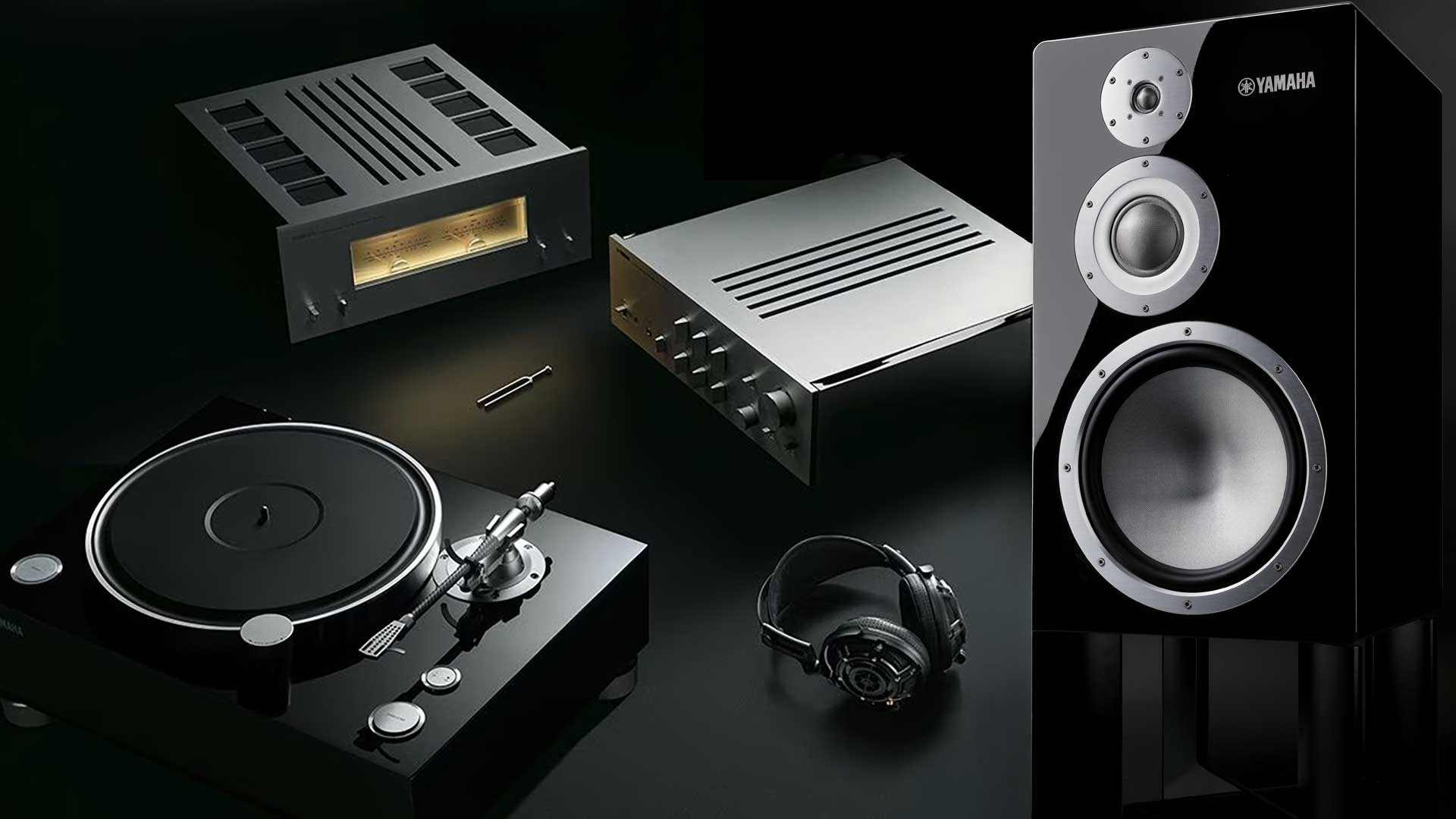
Yamaha’s hi-fi history in recent years has been dominated by the 5000 Series (pictured above), which was heralded by the NS-5000 speakers. Still carrying that ‘Natural Sound’ model prefix, they answered Yamaha audio division’s long-held wish to revisit the elements that made the NS-1000 and its pro version such a success.
The new NS-5000 does not feature beryllium, but Yamaha claims to have matched and possibly gone beyond this awkward element in “adopting a new development diaphragm with a speed of sound comparable to beryllium in all units” – the Japanese-developed artificial fibre called ‘Zylon’.
The 5000 Series amplifiers arrived next, and lastly the GT-5000 turntable, still ‘Giant & Tremendous’, completing a firmly all-analogue system.
The technology from the 5000 Series has trickled down into new 3000 Series and 2000 Series hi-fi, with the NS-2000A amplifier proving a particular success in marrying the MusicCast streaming and multiroom platform with the all-analogue amplification style of the higher series.
That became a template for lower 1000 Series models, bringing Yamaha’s 70 years of experience and expertise to affordable hi-fi as well as the Yamaha’s higher echelons, which were supplemented by 5000 Series orthodynamic headphones in 2004, the YH-5000SE, and then most recently at the Australian Hi-Fi Show in April, two lower models were shown – the orthographic YH-4000 open-backs, and a new dynamic closed-back headphone, the YH-C3000.
What's next for the Japanese company, after a century of audio innovation and delivery? Watch this space!

Jez is the Editor of Sound+Image magazine, having inhabited that role since 2006, more or less a lustrum after departing his UK homeland to adopt an additional nationality under the more favourable climes and skies of Australia. Prior to his desertion he was Editor of the UK's Stuff magazine, and before that Editor of What Hi-Fi? magazine, and before that of the erstwhile Audiophile magazine and of Electronics Today International. He makes music as well as enjoying it, is alarmingly wedded to the notion that Led Zeppelin remains the highest point of rock'n'roll yet attained, though remains willing to assess modern pretenders. He lives in a modest shack on Sydney's Northern Beaches with his Canadian wife Deanna, a rescue greyhound called Jewels, and an assortment of changing wildlife under care. If you're seeking his articles by clicking this profile, you'll see far more of them by switching to the Australian version of WHF.
You must confirm your public display name before commenting
Please logout and then login again, you will then be prompted to enter your display name.
